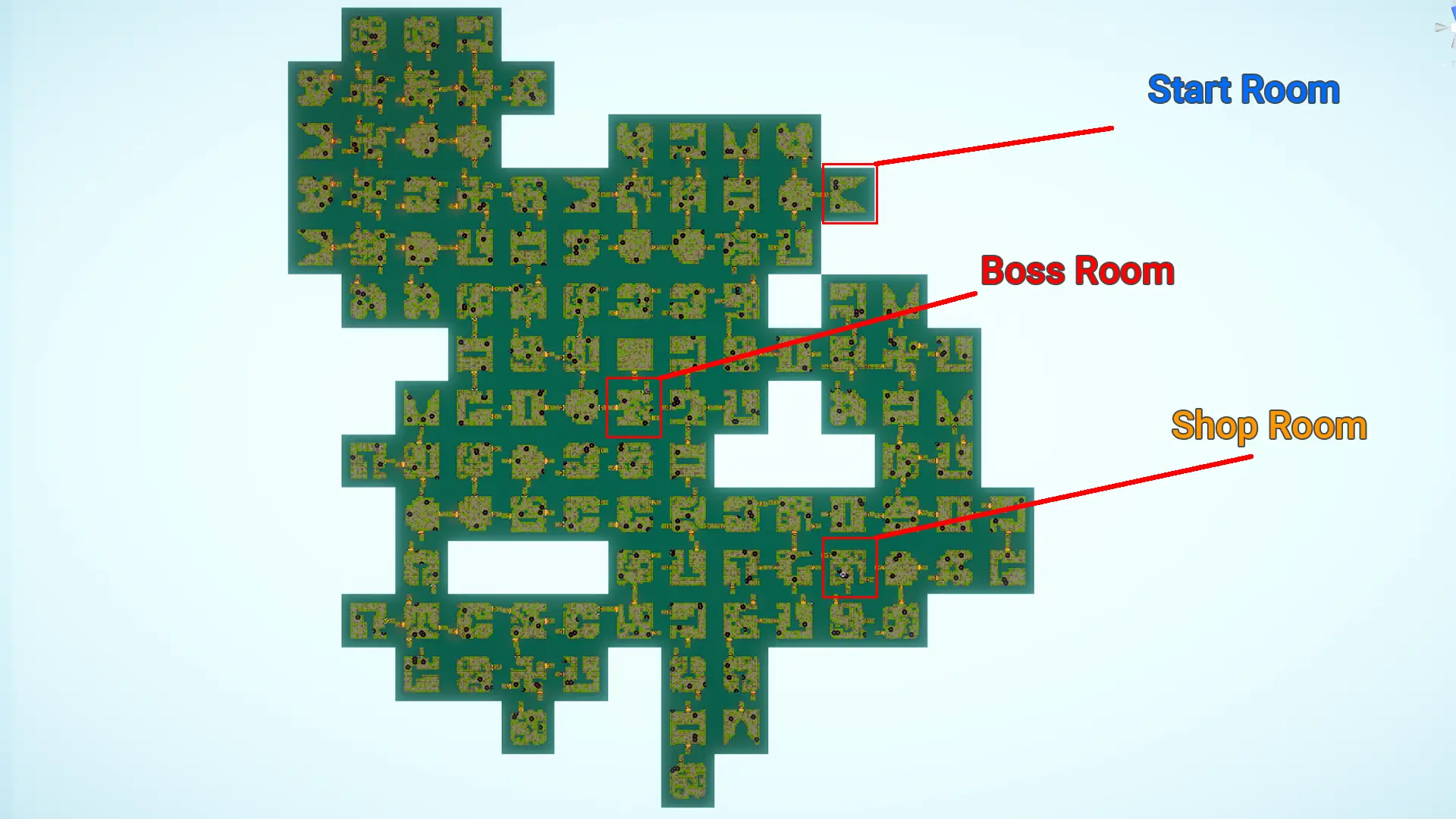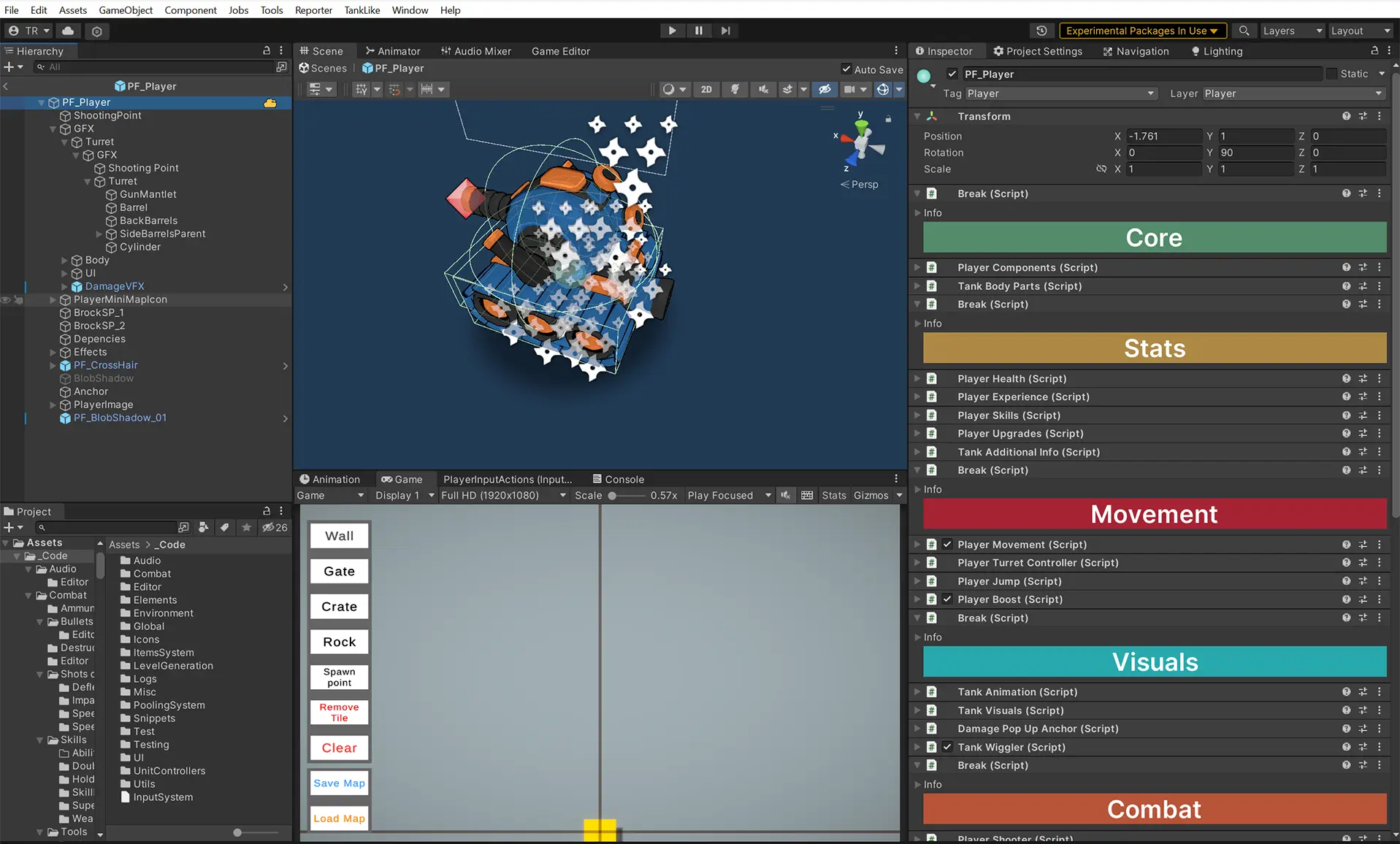Tanklike
I developed core gameplay mechanics, systems, and
tools for Tanklike.
I am also responsible for the tech art side of the project, creating shaders,
and a mapmaker for the game levels.
Tanklike is a top-down shooter rogue-like tank game that I've been developing
alongside a friend of mine.
Our shared enthusiasm for Battle City, a childhood favorite which we remade in 3D
three years ago,
inspired us to take on this new project.
Role: Gameplay Engineer, Tools Engineer, Systems Designer, Tech artist, Game
Designer
Game Engine: Unity
Programming Language: C#
Technologies: Adobe Photoshop, Blender, GitHub, Visual Studio, Audacity, Notion,
Trello
Platform: PC
Date: 2023 - ongoing
 Concept
Concept
Tanklike is a tank game where players pilot, upgrade, and customize their tanks to reclaim humanity's post-apocalyptic world ruled by rogue AI tanks in a procedurally generated world.
 Game Systems
Game Systems
While Tanklike is still in development, we have successfully implemented many of the core mechanics we envisioned, with a few remaining to be refined through further playtesting. Here are some of the key features and mechanics I have incorporated so far in the project:
Behavior Tree System
As we added more and more enemies, it became apparent to us that our state machine
system
was
starting to get messy.
Even though it was implemented in a modular and reusable way,
creating connections between states and keeping track of them was something we struggled
to
manage.
So, to help us steamline that part of the development,
and to get to do what I enjoy doing a lot (creating tools,)
I implemented a behavior tree node-based system for the Unity Editor
using
Unity’s
built-in Graph View, UI Toolkit and UI
Builder.
The visuals of the node editor were inspired by the ones in Unreal
Engine.
I used
UXML and USS to accomplish the current state of the
tool,
and it's
still work in progress.
I added a minimap to make navigating through the graph easier. This was one of
the
feature
that I wish Unreal had in their editor.
The Blackboard was a crucial feature of the system. I implemented it using
Unity's
built-in Blackboard system
and customized it to meet the specific needs of the project. This implementation allows
for
the creation of various data types
that can be easily accessed through code using a BlackboardKey variable.
Unlike the
blackboards found in Unity's Shader Graph and Animator,
where variable names must be typed manually, this system is foolproof, with all
variables
conveniently listed in a menu in the Inspector.
The behavior tree system is a flexible and visual approach to creating AI
behaviors
in
games.
It organizes actions and decisions into a hierarchical structure of nodes,
where each node represents a specific task or condition.
The tree traverses these nodes, evaluating conditions and executing actions based on
their
success
or failure which allows complex and dynamic decision-making.
The graph view makes it easy to create new behavior trees, and add, delete, copy, and
paste
new nodes.
Tank recoil system
In Tanklike, tanks experience a recoil effect when moving, halting, or firing, akin to real-life vehicles. Initially, we implemented a static recoil animation, which did the job at the time. However, to account for the varied dynamics of different actions, I developed the Tank Recoil System. This system performs dynamic animations by adjusting intensities and motion curves specific to each action. I used Unity's Scriptable Objects to store and reuse the values passed to the system to make it easy to adjust the values when needed.
Local Multiplayer
I added a couch multiplayer option. The system was implemented using Unity's new input system. The difficulty of the game dynamically increases in multiplayer mode.
Aim-assist
The game has an aim-assist feature that takes place when the player stops both movement and aim. This adds a little boost to players who have difficulties aiming in the game.
Player Skill Tree
In Tanklike, players can enhance their tanks
by
upgrading weapons, gaining new abilities, and increasing stats through a skill
tree.
A key challenge was enabling the UI to be navigable with button inputs for controller
users,
eliminating
the need for cursor control. I addressed this by developing a custom UI element
framework.
This framework includes a parent component that manages navigation through four
directional
slots,
with
each slot having a definable destination. The process of setting these destinations is
streamlined
with
a custom editor script.
This navigation setup is applied across all UI components, including the skill tree
cells.
I only implemented 5 skills in the skill tree as we haven't fully tested the game's
overall
progression.
It's still far down the project's timeline, but the system's core functionality is
working.
Procedural Level Generation
I designed and implemented a
procedural level generator
that dynamically constructs levels by connecting random rooms from a pool.
The game is a room-based game with camera transitions between rooms. This design
simplified
the
complexity of the level generation algorithm, as there were no hallways to connect the
rooms.
The system places key rooms—the boss room, the player start room, and the shop within
the
level
layout
and ensures they are not directly connected to one another.
As for further regions in the level, the player will be forced to look for 3 keys that
unlock
the
boss
room throughout the entire level.
P.S. The scale and number of rooms in the screenshot are exaggerated. The actual
game
has
fewer
rooms.

Dynamic Camera Controls
Camera control in Tanklike evolved as the project progressed. Initially, we utilized Cinemachine for basic follow mechanics, tracking the player's movement. However, to better meet gameplay needs, I developed an enhanced camera controller with several key features:
- The camera follows the player's cursor instead of the player directly, providing a better feeling when aiming and exploring.
- In two-player mode, the camera follows the midpoint between both players' cursors, ensuring both are always in view.
- The camera's following speed increases when a player is boosting, keeping the action in frame during high-speed movements.
- The camera zooms out during combat for a broader view and zooms in during safe periods for a more focused exploration.
- During key events, such as entering a boss room, the camera automatically focuses on the main targets to enhance the dramatic impact.
- At all times, the camera keeps the outer boundaries of the room out of view.
Tools Shop
Players have the opportunity to customize their gameplay through the Tools Shop. Here, players can purchase special tools that offer a range of abilities, which enhances their tactical options. These tools include attack enhancements, healing capabilities, and the ability to summon assistant bots, among others. Each tool has limited uses, adding a strategic layer to resource management. Additionally, players can sell tools they no longer need back to the shop in exchange for coins.
Editor Tools
I love messing with the Unity Editor scripts and frequently invest some development time creating tools that improve project and feature management. In addition to the bahavior tree I talked about above, I also added the following:
Mapmaker
I implemented a mapmaker tool that made the process of desinging rooms easier. With this tool, we could build the room using tiles, set spawn points for enemies, level props, and destructibles that drop collectables. The visuals of the individual tiles and props change depending on the level. The room is then saved as a scriptable object and can be viewed by the inspector by drawing a simplified version of it using a custom editor script.
Component Breaks
I implemented a little custom editor script that acts as a visual representation of a break between groups of components that are placed on the same game object. The font size, text, and colors can be set through a collapsable button in the break itself.

Other Responsibilities
Here's a list of other tasks that I was responsible for in the project:
- UI Programming: Developed scalable UI interaction systems compatible with both keyboard and controllers.
- Custom Utilities Scripts: Created attributes that ease the task of assigning references in the inspector, creating new Scriptable Objects, null checking, and more.
- QA sessions and playtests: Organized and conducted multiple playtests at community indie events, collecting feedback and addressing areas for improvement in weekly team meetings.
- Shaders creation: Designed and implemented a variety of custom shaders using Shader Graph, enhancing the visual style of the game.
- Documentation: Maintained thorough documentation for features, concepts, and systems to support future development and team reference.
- Script Templates: Created a custom script generator that streamlined adding new child classes—such as abilities, UI windows, and editor cheats—by integrating them seamlessly with pre-existing game features.